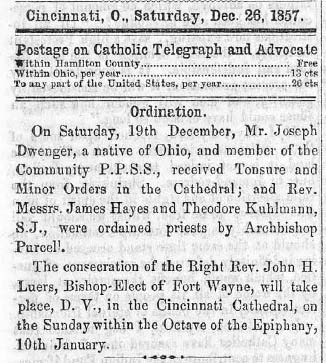Today marks the 156th anniversary of the establishment of the Diocese of Fort Wayne, now known as the Diocese of Fort Wayne-South Bend.  Since the establishment of the Diocese of Vincennes in 1834, which included the entire State of Indiana and the eastern half of Illinois, the area has been successively divided into smaller areas. First, Chicago, leaving the entire State of Indiana. Then in 1857, the State was divided in half between Vincennes and Fort Wayne. Then in 1944, Indianapolis divided with the Diocese of Evansville being created in the south and Fort Wayne divided to create the Dioceses of Lafayette. Gary came along in 1957.
Since the establishment of the Diocese of Vincennes in 1834, which included the entire State of Indiana and the eastern half of Illinois, the area has been successively divided into smaller areas. First, Chicago, leaving the entire State of Indiana. Then in 1857, the State was divided in half between Vincennes and Fort Wayne. Then in 1944, Indianapolis divided with the Diocese of Evansville being created in the south and Fort Wayne divided to create the Dioceses of Lafayette. Gary came along in 1957.
Here is a clipping from the Catholic Telegraph – December 26, 1857:
Notice that the news of the ordination to minor orders of Joseph Dwenger. Ironically, he would eventually follow Bishop Luers as the Second Bishop of Fort Wayne in 1872. News of Luers consecration as bishop is shown at the bottom of the article.
Here is how the Fort Wayne Diocesan web site puts it:
What we would consider the Fort Wayne area was first placed under the care of the Bishop of Quebec from 1674-1789. Then with the establishment of the Diocese of Baltimore the Fort Wayne area was under the jurisdiction of Bishop Carroll from 1789 until 1810. In 1810 it was under the Bishop Flaget, the Bishop of Bardstown, Kentucky. From 1834 to 1857 the Fort Wayne area was part of the Vincennes Diocese. Vincennes would later be the titular see, the Archdiocese of Indianapolis.
According to George Mather in his book, “Frontier Faith”, the earliest account of worship in the Fort Wayne area was December 20, 1789. Father Louis Payet, a priest from Detroit conducted,”eight services of worship in as many days.” At that time Fort Wayne was known as Miamitown and was under the jurisdiction of the Bishop of Quebec. Since the mid 1850″²s the Diocese of Fort Wayne has had nine Bishops, the list follows:
Bishop John Henry Luers Consecrated January 10, 1858
Bishop Joseph Dwenger Consecrated April 14, 1872
Bishop Joseph Rademacher
Arrived in Fort Wayne October 3, 1893 (transferred from Nashville)
Bishop Herman Joseph Alerding
Consecrated November 30, 1900
Bishop John Francis Noll
Consecrated June 30, 1925
Bishop Leo Pursley February 26, 1957
Bishop McManus October 19, 1976
Bishop John Michael D’Arcy May 1, 1985
Bishop Kevin C. Rhoades January 13, 2010In 1857 by the decree of Pope Pius IX, on January 8 the northern half of the state of Indiana was erected into the Diocese of Fort Wayne, the boundaries being that part of the state north of the southern lines of fountain, Montgomery, Boone, Hamilton, Madison, Delaware, Randolph and Warren Counties. The remaining southern half of the state made up the Archdiocese of Indianapolis.
In 1944, the Apostolic Decree of His Holiness Pope Pius XII established the diocese of Lafayette, from the southern twenty-four Counties of the Fort Wayne Diocese, approximately dividing the size of the diocese in half. The anniversary of that event was mentioned on this site
Also on the calendar this month, January 10th is the anniversary of the death of Archbishop Edward T. O’Meara. Born in Saint Louis and ordained by our own Archbishop Ritter, O’Meara served the Archdiocese of Indianapolis for about 13 years as Archbishop.
Here, once again, is the New York Times obituary which ran on January 11, 1992:
INDIANAPOLIS, Jan. 11 – Archbishop Edward T. O’Meara, who headed Catholic relief efforts for war and disaster victims around the world, died Friday at his home here. He was 70 years old.
Archbishop O’Meara, the spiritual leader of the 200,000 Roman Catholics in the Indianapolis Archdiocese, was found last summer to be suffering from pulmonary fibrosis, a lung disease.
The illness led him to resign in September as president and chairman of Catholic Relief Services, an agency in Baltimore that was created to help refugees during World War II and was expanded to a worldwide relief organization. Last year it distributed $230 million in aid to 74 countries.
He was elected to the first board of directors of Catholic Relief Services in the 1970″²s and became the agency’s president in 1987. Son of Irish Immigrants
Archbishop O’Meara, who headed a 39-county archdiocese that covers most of the southern half of Indiana, traditionally delivered the invocation before the Indianapolis 500 automobile race.
The son of Irish immigrants, he was born in St. Louis on Aug. 3, 1921, and was ordained there in 1946. He attended Kenrick Seminary in St. Louis and in 1952 earned a doctorate in theology at the Pontifical University of St. Thomas Aquinas in Rome.
He was named auxiliary bishop for the Archdiocese of St. Louis in 1972 and was installed as the fourth Archbishop of Indianapolis in 1980. He died 12 years to the day after his installation.
In an interview shortly after his installment, Archbishop O’Meara said his affinity for the Catholic Church was rooted in his childhood. I can never remember a time when I wasn’t drawn to it, he said.I liked to be around the priests. I liked what they did. I admired their wholesome life.”
Archbishop O’Meara left no immediate survivors.
